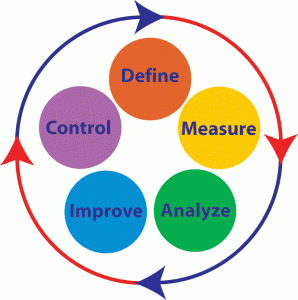What are six sigma resources?
The answer to the question “why is six sigma”, will give the answer to the question “what is six sigma resources?”
 A defect free products or services are the foundation stone for the success of an organization or of a project. A defect free products and services are the result of high quality production of an organization. Six sigma is the methodology of the production of defect free, high quality products. Six sigma provides with the requirements for the production of quality products and to meet the customer satisfaction for the survival of the organization in the field of competitive global marketing. Implementation of six sigma helps the organization to focus on the improving quality of the products and services through better, faster and cheaper means. In a broad sense, it is easy to explain the use of six sigma as “the methodology focusing on defect prevention, cycle time reduction, and cost savings”. Six sigma helps in finding out the identifying and elimination of cost that provides no values to the customer satisfaction.
A defect free products or services are the foundation stone for the success of an organization or of a project. A defect free products and services are the result of high quality production of an organization. Six sigma is the methodology of the production of defect free, high quality products. Six sigma provides with the requirements for the production of quality products and to meet the customer satisfaction for the survival of the organization in the field of competitive global marketing. Implementation of six sigma helps the organization to focus on the improving quality of the products and services through better, faster and cheaper means. In a broad sense, it is easy to explain the use of six sigma as “the methodology focusing on defect prevention, cycle time reduction, and cost savings”. Six sigma helps in finding out the identifying and elimination of cost that provides no values to the customer satisfaction.
From the above description it is clear that six sigma is a systematical analyzing of measurement quality for the production of best quality products and the better customer satisfaction. Six sigma has a proven history of highly effective quality principles and techniques. The aim of six sigma is of virtually defect free business performances.
For the implementation of high quality products and the customer satisfaction, there are certain resources in six sigma methodology. Trainings, seminars, and certifications for the specific skills are their major resources. There are two methods in six sigma, DMAIC & DMADV.
The former is used to improve an existing business process, while the second one is used either for creating a new product or for process designs for predictable and defect free performance. By DMAIC, it means giving importance to defining, measuring, analyzing, improving and controlling a process to meet its better quality. The implementation of the six sigma methodology helps in providing a logical sequence for existing concepts and the problem solving tools, by sufficient repackaging of the tools and concepts. Moreover, the methodology of the six sigma is used by the project sponsors at each step of conclusion before moving to the next step.
Six sigma trainings:
Training the professionals about the methodologies of six sigma, which is a flexible system, is the aim of the six sigma training. This training provides the professionals and the companies with skills of achievement, supporting, and maximizing business profits. The training is based on the understanding the needs of the customer, systematical use of the data and the facts, improving and reinventing the organizational processes using statistical analysis. The training is designed in such a way that it provides the trainees a full resources to help them to explain, simplify and set the right path in the implementation of the six sigma methodology for the better achievement of the organization to meet its better quality.
Besides the above said basic trainings, six sigma provides training under two sections to make the training more effective and clear. The two sections are as follows:
Management training with certifications
Six sigma belt training with certifications
Under each section, there are several sub-divisions, according to the needs and the commitments of the company towards the customer. Each section is having its own importance for the attainment of the defect free results.
Six sigma seminars:
 Six sigma seminars are instructional process, conducted for the candidates to know and discover how to apply systematically the statistical methods of six sigma for the organizational growth and for customer satisfaction. Instructions are given to the candidates about the importance and usage of data, information, analysis, and communication for a successful problem solving.
Six sigma seminars are instructional process, conducted for the candidates to know and discover how to apply systematically the statistical methods of six sigma for the organizational growth and for customer satisfaction. Instructions are given to the candidates about the importance and usage of data, information, analysis, and communication for a successful problem solving.
Six sigma seminars are conducted on the effective application of the six sigma theories and process, to make sure that the candidates are able to apply their knowledge effectively to assist the organizations to achieve the best in the global marketing. It also helps in reducing the costs, improving the time, eliminating the defects and improving the quality and the satisfaction of the customer.
Seminars are organized in such a way for the participant’s to use it friendly for the complete understanding of the methods used in six sigma. The participant’s are provided with training certificates after the completion of each seminar. The below mentioned topics are the different subjects offered for the six sigma seminars.
Measurement systems analysis
Process capability and performance
Advanced statistical methods
Design and analysis of experiments
Statistical process control and management
Six sigma certifications:
Six sigma certification give importance in giving training to the appropriate subject matter, through written proficiency test. This training provides with the displaying competency in the hands of the person. Six Sigma Certification has given by the training and consulting company, who is conducting the training. Even the companies hiring the training programs can give the tests. The tests may differ according to the training company’s proficiency. Companies performing training for years have created and administrated written proficiency tests of their own.
Once the certification training is completed, one must complete one or two quality projects. This is the time for the trainees to display the competency in applying the concepts learned. This part of the training differs according to the companies, and hence the quality projects are the fuzziest and the undefined part of the six sigma certification.
Under six sigma certification comes three types of certifications. They are:
Green belt certification
Black belt certification
Master black belt certification
Apart from this certification, there are yellow certification and lean certification. The word belt refers to the level six sigma projects to be performed. Business leaders processing six sigma through the projects are known as the champions. They are trained according to the six sigma methodology, which aims at the selection of the projects that are related with business goals. These champions are to select and monitor six sigma project leaders, who were called the “belts”. Six sigma certification requires both projects and training
CSSGB- Six Sigma Green Belt Certification
Here the six sigma green belt operators are given training to operate in the support or under the supervision of a six sigma black belt. Through this certification the person is trained to analyze and solve quality problems. This results in the quality improvement projects. The person, who had undergone the six sigma green belt certification, has at least three years of work experience in demonstrating the knowledge of six sigma tools and processes.
CSSBB- Six Sigma Black Belt Certification
The candidate who had undergone six sigma black belt certification is a professional who is capable in the explanation of six sigma philosophies and the principles. His knowledge also includes the supporting systems and the tools. This certification also deals with the training of the candidate in developing the demonstrating of the team leadership, understanding team dynamics and assigning team member roles and responsibilities. A six sigma black belt will be well versed will all the aspects of the DMAIC model in accordance with the six sigma principles. These professionals have basic knowledge of lean enterprise concepts. They are capable in identifying non-value added elements and activities. They are also capable in the use of specific tools
Master Black Belt Certification
The professionals who had undergone the master black belt certification are considered as a six sigma quality experts and they are responsible for the strategic implementations within an organization. The training is given for the improvement of the responsibilities of a master black belt, which includes training and mentoring of black belts and the green belts. Moreover the responsibilities or the duties of a master black belt extend to the range of helping the both belts in prioritizing, selecting and charting high impact projects.
Maintaining the integrity of the six sigma measurements, improvements and developing, revising six sigma training materials, qualifying or teaching the other six sigma facilitators about the methodologies, tools and applications in all functional areas of a company are some of the other responsibilities of a person who has completed master black belt certification.
Yellow Belt Certification
Six Sigma Yellow Belt certification provides with the attendees an overall insight to the use age of the six sigma techniques. The training is also given in the field of six sigma metrics and the basic improvement methodologies. It is essential for six sigma yellow belt to learn how to integrate lean and six sigma methodologies to get the high level production and transactional systems. This is to meet the customer’s expectations and the objectives of the organization from the bottom, to its best. The certification helps the trainees to receive an idea about the introduction to the process management and the basic tools of six sigma. Strong understanding of the processes, enabling each individual to provide meaningful assistance is the other characteristics of the six sigma yellow belt certification. The aim of this certification is the achievement of the organizations overall objectives.
Lean Six Sigma Certification
 Lean six sigma certification provides the professionals with both techniques of service and manufacturing in industries. Along with this lean certification makes an individual attain the following requirements:
Lean six sigma certification provides the professionals with both techniques of service and manufacturing in industries. Along with this lean certification makes an individual attain the following requirements:
– Focusing how to move fast in order to accomplish the objectives with in the industry.
– Involves in business enterprise, identifies and eliminates the activities which do not provide values to the product or to the service given to the customer.
– Awareness of the lean and six sigma methodology help the business enterprise in attaining a stable improvement.
– The improvement will start from the bottom level and will be having a fast accomplishment
– Identifying the potential areas, deciding the improvements, meeting the customer expectation and the business results are other fields in which the trainees concentrate.
– Emphasis is given in chasing the variations and waste out of the system, so as to make sure that the improvements are sustained.
In an organization, the project sponsor seeks the help of six sigma methodology under several situations like:
When the cause of the low quality performance is unknown
When problems are found in common places
When the problems found are not able to well defined
When the approaches made are not inappropriate
When all the problem solving methods fail
When complex situations arises with many variables
 In an organization, at the time of production of a product six sigma methodology is implemented in order to avoid defects and wastes and make sure that the product meets the customer satisfaction. At the time of six sigma quality improvement, a lot of money is at the risk point and if unproductive changes are taken or made, it leads to lot of loss to the company in both the finance and productive aspects. In order to avoid such a loss, it is that important in a business to test the efficacy of the changes made. This test can be done with the help of hypothesis tools and testing.
In an organization, at the time of production of a product six sigma methodology is implemented in order to avoid defects and wastes and make sure that the product meets the customer satisfaction. At the time of six sigma quality improvement, a lot of money is at the risk point and if unproductive changes are taken or made, it leads to lot of loss to the company in both the finance and productive aspects. In order to avoid such a loss, it is that important in a business to test the efficacy of the changes made. This test can be done with the help of hypothesis tools and testing. The main aim of the implementation of six sigma in to a project team is to define the correct testing parameter. The faults in defining the objectives and the testing parameters, results in difficulty to ensure the success of the proposed changes. Even a small fault in the proposed change can result severely in the business process where it is being implemented. So it is better to use the hypothesis testing for attaining the accurate results of the testing.
The main aim of the implementation of six sigma in to a project team is to define the correct testing parameter. The faults in defining the objectives and the testing parameters, results in difficulty to ensure the success of the proposed changes. Even a small fault in the proposed change can result severely in the business process where it is being implemented. So it is better to use the hypothesis testing for attaining the accurate results of the testing. Apart form the above advantages there are limitation for the using of hypothesis testing, in testing the effectiveness of a proposed changes. This is because, there are even many more factors that can affect a business process. Some of these factors are employee dissatisfaction, changes in the technology etc which cannot be tested with the help of hypothesis testing. There fore it is the duty of the analyst to make sufficient arrangements for all these types of testing and these test results can be used to compare with the hypothesis results to find out a proposed change, which confirms to suggested hypothesis.
Apart form the above advantages there are limitation for the using of hypothesis testing, in testing the effectiveness of a proposed changes. This is because, there are even many more factors that can affect a business process. Some of these factors are employee dissatisfaction, changes in the technology etc which cannot be tested with the help of hypothesis testing. There fore it is the duty of the analyst to make sufficient arrangements for all these types of testing and these test results can be used to compare with the hypothesis results to find out a proposed change, which confirms to suggested hypothesis. Knowing more about the importance and the elements of six sigma is the six sigma basics. The basics of six sigma help us to understand “the science behind the theory of improvement”. It deals systematically with steps of instructions and certifications. For an organization to understand the potential of six sigma implementation, it is a must for the team members to have a minimum solid understanding about the understanding of the six sigma methodology. The methodology of six sigma contains its objectives, potential benefits, roles and common tools.
Knowing more about the importance and the elements of six sigma is the six sigma basics. The basics of six sigma help us to understand “the science behind the theory of improvement”. It deals systematically with steps of instructions and certifications. For an organization to understand the potential of six sigma implementation, it is a must for the team members to have a minimum solid understanding about the understanding of the six sigma methodology. The methodology of six sigma contains its objectives, potential benefits, roles and common tools. According to six sigma every piece of work done is considered as a processes. There are certain steps to be followed to find out a defined process. Since the process is the result of series of actions, changes and functions, there should be a well planning on the process to be conducted. A well defined planning of the process is a must, and the six sigma basics carefully deals with the topic.
According to six sigma every piece of work done is considered as a processes. There are certain steps to be followed to find out a defined process. Since the process is the result of series of actions, changes and functions, there should be a well planning on the process to be conducted. A well defined planning of the process is a must, and the six sigma basics carefully deals with the topic. The process according to six sigma is the total number of sequences, series and the arrangements of events, steps or measurements done repeatedly for the production of quality products or services. Changing a process is the first step in a six sigma improvement program in order to reduce the costs and improve quality. There are different types of graphical representation for a process or procedure to show its flow type style of all actions and conclusion taking place in a process. There are process maps, flow charts, and SIPOC diagrams used for the graphical representation of the process.
The process according to six sigma is the total number of sequences, series and the arrangements of events, steps or measurements done repeatedly for the production of quality products or services. Changing a process is the first step in a six sigma improvement program in order to reduce the costs and improve quality. There are different types of graphical representation for a process or procedure to show its flow type style of all actions and conclusion taking place in a process. There are process maps, flow charts, and SIPOC diagrams used for the graphical representation of the process. The elements contained in a graphs are the starting point to the process and its sub-processes, an ending points to the process and its sub-processes, inputs, outputs and other types of direction and decisions which leads to another potential direction.
The elements contained in a graphs are the starting point to the process and its sub-processes, an ending points to the process and its sub-processes, inputs, outputs and other types of direction and decisions which leads to another potential direction. With in an organization, the objective is the long-term improvement of its processes in order to enhance the performance of the organization and the products, gain the interest of the customers, employees and shareholders, and thus sustain in the world of global marker competitive. Still just improving a process is not a complete business option, but a complete process re-design is required.
With in an organization, the objective is the long-term improvement of its processes in order to enhance the performance of the organization and the products, gain the interest of the customers, employees and shareholders, and thus sustain in the world of global marker competitive. Still just improving a process is not a complete business option, but a complete process re-design is required. It is better to replace DMADV, than the other way. There are two occasions in which DMADV can be used to replace DMAIC. One occasion is at the time there is no existing product, out of which the organization is aiming to create from the scratch. At the time when the implementation of DMAIC has not produced the expected result, though best efforts are done to make the improvements, DMADV methods can be used. It is proved that there are situations where planned DMAIC is been replaced by the use of DMADV method. The method is used at the time when the “improvement” process is not able to deliver the organization the expectations.
It is better to replace DMADV, than the other way. There are two occasions in which DMADV can be used to replace DMAIC. One occasion is at the time there is no existing product, out of which the organization is aiming to create from the scratch. At the time when the implementation of DMAIC has not produced the expected result, though best efforts are done to make the improvements, DMADV methods can be used. It is proved that there are situations where planned DMAIC is been replaced by the use of DMADV method. The method is used at the time when the “improvement” process is not able to deliver the organization the expectations. Six Sigma is an data driven approach used by many organizations that strives to achieve quality & perfection. It is a methodology used to eliminate defects & to determine the performance of the process. A defect is anything that is outside or against customer requirements. To achieve this, a process should not produce defects more than 3.4 per million opportunities.
Six Sigma is an data driven approach used by many organizations that strives to achieve quality & perfection. It is a methodology used to eliminate defects & to determine the performance of the process. A defect is anything that is outside or against customer requirements. To achieve this, a process should not produce defects more than 3.4 per million opportunities. Six sigma tutorial means, the lessons or a manual or a section of computer program, which is designed to provide instruction and training for six sigma with the use of exercises and assignments. Six sigma tutorial is a document of full tutorial about the six sigma topics.
Six sigma tutorial means, the lessons or a manual or a section of computer program, which is designed to provide instruction and training for six sigma with the use of exercises and assignments. Six sigma tutorial is a document of full tutorial about the six sigma topics. Six sigma case study refers to the building up of the framework, about the six sigma methodology in the minds of the organizations. Here studies are made on the topic “what are the benefits of six sigma methodology in the development of an organization and a project?” . case studies are made on different fields of organizations like IT, call centers, large companies based in the US and India etc. This case study helps in finding out the areas in which six sigma is effective and what aspects of six sigma is more effective and is been used by the organizations for the development.
Six sigma case study refers to the building up of the framework, about the six sigma methodology in the minds of the organizations. Here studies are made on the topic “what are the benefits of six sigma methodology in the development of an organization and a project?” . case studies are made on different fields of organizations like IT, call centers, large companies based in the US and India etc. This case study helps in finding out the areas in which six sigma is effective and what aspects of six sigma is more effective and is been used by the organizations for the development. A defect free products or services are the foundation stone for the success of an organization or of a project. A defect free products and services are the result of high quality production of an organization. Six sigma is the methodology of the production of defect free, high quality products. Six sigma provides with the requirements for the production of quality products and to meet the customer satisfaction for the survival of the organization in the field of competitive global marketing. Implementation of six sigma helps the organization to focus on the improving quality of the products and services through better, faster and cheaper means. In a broad sense, it is easy to explain the use of six sigma as “the methodology focusing on defect prevention, cycle time reduction, and cost savings”. Six sigma helps in finding out the identifying and elimination of cost that provides no values to the customer satisfaction.
A defect free products or services are the foundation stone for the success of an organization or of a project. A defect free products and services are the result of high quality production of an organization. Six sigma is the methodology of the production of defect free, high quality products. Six sigma provides with the requirements for the production of quality products and to meet the customer satisfaction for the survival of the organization in the field of competitive global marketing. Implementation of six sigma helps the organization to focus on the improving quality of the products and services through better, faster and cheaper means. In a broad sense, it is easy to explain the use of six sigma as “the methodology focusing on defect prevention, cycle time reduction, and cost savings”. Six sigma helps in finding out the identifying and elimination of cost that provides no values to the customer satisfaction. Six sigma seminars are instructional process, conducted for the candidates to know and discover how to apply systematically the statistical methods of six sigma for the organizational growth and for customer satisfaction. Instructions are given to the candidates about the importance and usage of data, information, analysis, and communication for a successful problem solving.
Six sigma seminars are instructional process, conducted for the candidates to know and discover how to apply systematically the statistical methods of six sigma for the organizational growth and for customer satisfaction. Instructions are given to the candidates about the importance and usage of data, information, analysis, and communication for a successful problem solving. Lean six sigma certification provides the professionals with both techniques of service and manufacturing in industries. Along with this lean certification makes an individual attain the following requirements:
Lean six sigma certification provides the professionals with both techniques of service and manufacturing in industries. Along with this lean certification makes an individual attain the following requirements: Six sigma system is the specialized package of six sigma methodology, lean manufacturing programs and consulting services. Six sigma system rely on quality results of the products or services to meet the customer satisfaction, through better quality faster. The programs are set to meet the needs of the clients. The application of six sigma system depends on the business goals, opportunities and organizational landscape. It is on the basis of these three factors, six sigma system is designed and customized. Six sigma system always try to meet the industry standard through the practice of six sigma and lean manufacturing principals. According to six sigma system, the measurement of success is been measured on the client’s success and not on the number of clients or people trained, in six sigma system.
Six sigma system is the specialized package of six sigma methodology, lean manufacturing programs and consulting services. Six sigma system rely on quality results of the products or services to meet the customer satisfaction, through better quality faster. The programs are set to meet the needs of the clients. The application of six sigma system depends on the business goals, opportunities and organizational landscape. It is on the basis of these three factors, six sigma system is designed and customized. Six sigma system always try to meet the industry standard through the practice of six sigma and lean manufacturing principals. According to six sigma system, the measurement of success is been measured on the client’s success and not on the number of clients or people trained, in six sigma system. The philosophy of lean manufacturing is derived from the “Toyota Production System”. Lean manufacturing is a generic process of management, for the production of goods through the removal of waste and implementing the flow. The operational strategy in lean manufacturing gives importance in the achievement of better production of goods that meet the customer’s satisfaction, through the process of shortest possible cycle time by eliminating waste and reducing incidental work. Lean manufacturing is a technique which helps in decreasing the time between the customer need and the shipment. It is designed in a way that there is a rapid improvement in the profit, gaining the customer satisfaction, reducing the production of time and sustaining the employee emotions. In general it is said that lean manufacturing is considered as a company’s “half human effort, the half manufacturing space, the half investment in tools and the half engineering hours for the development of a new product with in the half time scheduled”. It is clear that the benefits gained through the implementation of lean manufacturing is the lower costs, higher quality and shorter lead time for the production.
The philosophy of lean manufacturing is derived from the “Toyota Production System”. Lean manufacturing is a generic process of management, for the production of goods through the removal of waste and implementing the flow. The operational strategy in lean manufacturing gives importance in the achievement of better production of goods that meet the customer’s satisfaction, through the process of shortest possible cycle time by eliminating waste and reducing incidental work. Lean manufacturing is a technique which helps in decreasing the time between the customer need and the shipment. It is designed in a way that there is a rapid improvement in the profit, gaining the customer satisfaction, reducing the production of time and sustaining the employee emotions. In general it is said that lean manufacturing is considered as a company’s “half human effort, the half manufacturing space, the half investment in tools and the half engineering hours for the development of a new product with in the half time scheduled”. It is clear that the benefits gained through the implementation of lean manufacturing is the lower costs, higher quality and shorter lead time for the production. Lean manufacturing is used under two approaches. The first approach is used for the identification and the continuous elimination of the waste. It is clear that as the waste is being eliminated, the quality of the product improves, while the production time and cost is reduced. The second approach to lean manufacturing, is focusing on improving the “flow” of the work. By the word flow means, the smoothness of the work. in the second approach the focus is given in the smoothening of the work, through the system and not the waste reduction. The second approach was promoted by Toyota.
Lean manufacturing is used under two approaches. The first approach is used for the identification and the continuous elimination of the waste. It is clear that as the waste is being eliminated, the quality of the product improves, while the production time and cost is reduced. The second approach to lean manufacturing, is focusing on improving the “flow” of the work. By the word flow means, the smoothness of the work. in the second approach the focus is given in the smoothening of the work, through the system and not the waste reduction. The second approach was promoted by Toyota. A Chi Square test also called as Chi-squared is a statistical hypothesis test that has a chi-square distribution when the null hypothesis is true. This test is most commonly used to observe what results are obtained by comparing given data with the expected data. This test is conducted to prove that there will be no change or difference between actual & expected data. The Chi-Square formula is sum of the squared difference between the actual & expected data, divided by the expected data.
A Chi Square test also called as Chi-squared is a statistical hypothesis test that has a chi-square distribution when the null hypothesis is true. This test is most commonly used to observe what results are obtained by comparing given data with the expected data. This test is conducted to prove that there will be no change or difference between actual & expected data. The Chi-Square formula is sum of the squared difference between the actual & expected data, divided by the expected data. India is a country where there are many companies who looks for the measure of goodness for their products and customer satisfaction. They always opt for a systematical and statistical improvement in the business world. Hence the implementation of the six sigma, for the effective operating system and to reduce the variation by avoiding defects and reducing waste is very much important for a country like India. Keeping this in mind, many companies in India opts the help and training of the six sigma methodologies, for the company professionals.
India is a country where there are many companies who looks for the measure of goodness for their products and customer satisfaction. They always opt for a systematical and statistical improvement in the business world. Hence the implementation of the six sigma, for the effective operating system and to reduce the variation by avoiding defects and reducing waste is very much important for a country like India. Keeping this in mind, many companies in India opts the help and training of the six sigma methodologies, for the company professionals. India gives importance to the DMAIC methodology in six sigma. The methodology of six sigma has two sub-divisions. They are DMAIC & DMADV. The former is used to improve an existing business process, while the second one is used either for creating a new product or for process designs for predictable and defect free performance. By DMAIC it means giving importance to defining, measuring, analyzing, improving and controlling a process to meet its better quality. The implementation of the six sigma methodology, helps in providing a logical sequence for existing concepts and the problem solving tools, by sufficient repackaging of the tools and concepts. Moreover the methodology of the six sigma is used by the project sponsors at each step of conclusion before moving to the next step.
India gives importance to the DMAIC methodology in six sigma. The methodology of six sigma has two sub-divisions. They are DMAIC & DMADV. The former is used to improve an existing business process, while the second one is used either for creating a new product or for process designs for predictable and defect free performance. By DMAIC it means giving importance to defining, measuring, analyzing, improving and controlling a process to meet its better quality. The implementation of the six sigma methodology, helps in providing a logical sequence for existing concepts and the problem solving tools, by sufficient repackaging of the tools and concepts. Moreover the methodology of the six sigma is used by the project sponsors at each step of conclusion before moving to the next step.